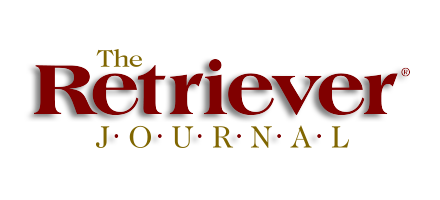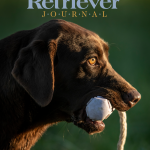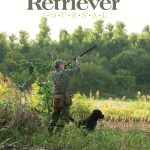No reason age should keep a good dog down.
by E. Donnall Thomas Jr.
Editor-at-Large
Photos by Don & Lori Thomas
“With mirth and laughter let old wrinkles come.” —William Shakespeare, The Merchant of Venice
It was a tough day in Washington’s Columbia Basin, where Lori and I do a lot of our duck hunting. We had driven all the way from Montana to find that an exceptional cold snap had left familiar ponds locked in ice. Being smarter than we were, the ducks had all pulled up stakes and headed for open water on nearby rivers. The end of the season was nearing, and we really wanted to enjoy a few more days of hunting. So did the dogs. Rosy, well known to readers by now, had just turned 10. I expected this to be the last season for her and the end of an era for me.
Then a Plan B appeared out of nowhere. Michael, our best friend in the area and a highly experienced hunter, lives right on the banks of the Yakima River with his wife, Gretchen. He reported that a variety of ducks were trading back and forth right in front of his yard and invited us over for some shooting before dinner.
In addition to Rosy and Lori’s Jack Russell, we had brought along Kiska and Max. Rosy’s half-sister, Kiska had proven a disappointment as a water dog; and, as I have previously discussed, Max, our male German wirehair, proved a pleasant surprise as a duck hunter. He wasn’t as stylish as my better Labs, but his enthusiasm and determination made him a welcome transition between Rosy and the new puppy for whom my search had just begun.
Walking across Michael’s yard to the river immediately confirmed his report. Ducks were flying upstream and down, and they weren’t just mergansers and goldeneyes. Driven from their usual habitat by ice, mallards appeared regularly along with the area’s usual assortment of puddle ducks. However, I immediately recognized that shooting there without a capable dog would be irresponsible if not downright unethical.
The bank on the leading edge of our friends’ yard consisted of a sheer six-foot vertical drop into deep water. The current was blowing higher and faster than I’d ever seen it. Looking along the downstream bank, all I could see was 200 yards of thick brush extending into the current. I’m a strong swimmer – or at least I used to be – but I wouldn’t have jumped in on a dare.
There was a time when Rosy could have handled the job easily enough, but that time had passed. I wasn’t worried as much about the current as I was about her ability to get back out. The water was moving so fast that she couldn’t possibly swim upstream against it. She would have to exit the water far below the point of entry and fight through thick brush while the river tried to take her all the way to the Pacific.
“I worked my Lab in it a couple of days ago,” Michael said when I expressed my reservations. “I know Rosy, and she’ll probably be fine.”
“Your dog is five years old,” I pointed out. “And ‘probably’ just isn’t good enough.
Despite my reluctance to miss what might be our last shooting of the season, as we turned and headed back to the house to fire up the charcoal grill, I knew I’d made the right call.
As I’ve mentioned here before, Editor Emeritus Steve Smith advised me long ago to avoid writing about dying dogs. Wise council – those events are hard on all of us, and we don’t need to read about them. Don’t worry; that’s not where we’re headed here.
However, dogs do age, and I suspect that most readers share my desire to enjoy their company in the field as long as possible. As with people, the point at which age begins to impact performance and safety varies considerably, and you can’t just define it in years. I’ve had dogs that looked and acted old at eight and others that were still eager and capable when they were 12.
One obvious key to extending a retriever’s working life is maintaining optimal health. Here I’ll discuss some of the commonest health-related issues that can compromise an older dog’s performance and safety. While dogs face many age-related health problems as they age, including loss of bladder control and cancer, I’ll focus here on those most likely to affect the working retriever. A lot of what I know about the subject derives from my 40 years of experience with human medicine, which does not automatically apply to dogs, although the principles are similar. Our regular veterinary columnist, Dr. Ben Character, has graciously reviewed the following information to ensure I haven’t overstepped my bounds. When in doubt, consult your vet.

It’s not just the cold: The heat of early season upland hunting will have greater effect on an older dog.
Overweight. Keeping the dog at proper weight is a good first step. Most of us tend to put on pounds as we age, and that’s likely the default position for dogs, too. A lot of that weight-gain reflects decreased caloric expenditure from less exercise as well as metabolic changes such as decreased levels of thyroid and sex hormones. However, increased food intake has an even greater impact on weight. As a wise old physician once told me, the only dietary ingredient known to be harmful to most of us is the calorie. Many commercial foods provide too many calories as carbohydrates. Dogs are carnivores, not omnivores. Since their ancestors fed at irregular intervals, some degree of ketosis may be their natural metabolic state. I usually “eyeball” food portions in my younger dogs, who can burn off excess calories during normal exercise. However, I measure food intake in my older dogs and cut back progressively if they are gaining weight, which should be monitored regularly on a scale if it seems to be changing in either direction. (Unexplained weight loss can be a symptom of a serious problem, and should be evaluated promptly by a veterinarian.) Feed according to the dog’s appearance. High quality dog food specifically formulated for older dogs will help maintain fitness. While it’s controversial, unless they are gaining too much weight, I feed my old dogs table scraps just to provide a diversity of nutrients.
Deconditioning. While exercise may not be crucial to managing an aging dog’s weight, it is important to maintain a level of conditioning adequate to keep the dog performing and comfortable in the field. Working retrievers require more conditioning than dogs lounging around the house. Specific goals and regimens are less important than regularly giving the dog an opportunity to romp at his own pace. Circumstances allowing, a daily walk in a safe, open place where the dog can run as he wishes should be sufficient. I don’t road my older dogs behind my truck as I periodically do when they are younger. If the dog shows no interest in anything more strenuous than plodding along at your side, it’s probably time for him to retire from the field.
Arthritis. A long, active life can be hard on joints, as most of us eventually find out for ourselves. Underlying problems like hip dysplasia often go unrecognized by owners until the dog ages. More often, the problem is simply degenerative arthritis due to accumulated wear and tear. Signs of arthritis include decreased general endurance, a change in gait, appearance of pain when a joint is manipulated, and localized muscle atrophy. These signs warrant a trip to the vet for an evaluation that may include x-rays or even more advanced imaging studies. Treatment often begins with a simple oral NSAID (non-steroidal anti-inflammatory drug) given by mouth, which can be quite effective in improving comfort and performance. Complicated problems may justify more aggressive medical treatment such as targeted injections or even surgery, topics beyond our scope here.
Hearing. As most of us over 50 know, senses become less acute with age. Dogs of any age often demonstrate “selective” hearing loss, obeying commands they want to obey and ignoring the rest. This behavior does not necessarily reflect organic hearing loss. But when a dog starts ignoring commands he once obeyed readily, the explanation is often age-related hearing loss, which is rarely treatable. However, the handler does have options to help mitigate the problem. I’ve always used a whistle as my primary means of audial communication in the field, and that principle becomes even more important as dogs age. Dogs hear whistle blasts better than human voices, no matter how loud. Lower-pitched whistles may be more effective than shriller models since, at least in people, this kind of hearing loss selectively affects high frequency sounds. If you have taught the dog to respond to hand signals, use them routinely to replace verbal commands.
Vision. Even significant visual impairment often goes unnoticed. I often observe a decline in marking ability in my dogs around age 10, which is often an indication of failing vison. Looking around in confusion after receiving a routine verbal command is another sign. While many cases of age-related vision decline can’t be treated, cataracts are one common problem that can be addressed surgically. The decision to proceed with aggressive intervention is personal and depends on several factors, including the dog’s overall health, life expectancy, and expectations for its future performance.
With health and conditioning issues addressed, it’s time to get the dog back into the field, as long as he remains interested. However, I modify my approach to hunting my dogs as they grow older, beginning with expectations for a day afield.

If we can all be so lucky in retirement…
As our readers know, versatility is one of the rewarding characteristics of the retrieving breeds. They may have been bred for waterfowl originally, but today they are as likely to be found in pheasant cover as in duck blinds. Upland hunting poses its own challenges for dogs as they grow older. Early grouse season here in Montana can see temperatures in the 90s, and older dogs don’t tolerate heat the way they once did. With age, they become more prone to dehydration, which they tolerate poorly. Charging up hills and through thick cover is more physically demanding than sitting in a duck blind. While I don’t always leave my aging Labs behind during upland hunts, I pick my days to avoid extreme temperatures, monitor them closely while hunting, and offer them plenty of water. Most of my dogs hunt waterfowl longer than pheasants.
This is not to say that duck hunting doesn’t pose problems for aging dogs. Older people are more susceptible to hypothermia than younger people, and I’m sure the same holds true for retrievers. I do a lot of cold weather duck hunting, but as a dog ages, I lower my threshold for leaving him behind on really cold days.
Cold weather poses problems other than outright hypothermia. Climbing up out of the water onto an ice shelf, a routine requirement during late season retrieves, requires strength and coordination. Even an experienced dog that has mastered that challenge for many seasons may lose that ability with age. Facing such conditions now, I’m likely to keep an aging veteran in the blind and let a younger dog do the heavy lifting. Enthusiastic dogs likely won’t recognize their new limitations (just like enthusiastic hunters), so the handler will have to make that call for them.
I don’t routinely fit my dogs with insulating vests just because they’re going into the water. Now, I frequently put neoprene vests on my older dogs in cold conditions. Getting a vest on the dog may be a bit of a struggle – Rosy has always hated hers – but I consider that effort worthwhile.
The psychological and personal aspects of dealing with aging dogs can be more difficult to navigate than the purely physical. Readers have likely worked out their own approach to these issues, as they should. I can only speak from personal experience.
I think the goal should be to land somewhere between two opposing management options: (1) Pushing the dog harder than he wants to go; and (2) prematurely retiring the dog to the house when he’s still eager and capable of hunting. I aim to land in the middle.
Dogs may not be able to talk, but they can give clear indications of their desire to hunt if we take the time to understand them. Kenai, one of my old males, made the call easy when he was around age 10. One December afternoon, I dropped the third mallard of the day in a snowbank across a little slough where I’d placed some decoys. His behavior during the first two retrieves had been unremarkable, but after he dropped the third bird in my hand, he shuffled back toward the truck and never went hunting again. He had told me he was done, and I didn’t argue. He went on to spend two more years playing with the kids and eating a lot of table scraps.
Rosy represents the opposite end of the spectrum. While she is now content to spend most days inside the house hoping for something edible to fall to the floor, whenever I put my whistle around my neck or pick up a shotgun case, she usually beats me to the door. If I grab some dummies on the way out, she recognizes that she’s going to do some retrieving rather than just taking a walk and starts bouncing around like a puppy. Hunting together before I made that call on the banks of the Yakima, she whined pathetically if I gave a retrieve that was newly beyond her paygrade to a younger dog. She was announcing that she was not ready to retire just as clearly as Kenai announced that he was.

There’s nothing sweeter than seeing an aging retriever with the heart to keep going, especially to a spot that will provide chip-shot retrieves.
A summary here sounds as if I’m telling you all what you likely know already, but some of these points bear repeating. Retrievers become different dogs as they age. Their physical capabilities require constant reassessment, ideally with advice from a veterinarian who understands the breed. The decision to retire the dog should be made by careful observation of his behavior rather than an arbitrary number of years. The dog may need to be withheld from work he once handled with ease. Safety for the dog should always be the prime consideration.
Do all this right and you and an old favorite may scratch out another season together in the field before it’s time to focus your attention on that new puppy.





